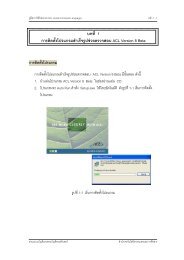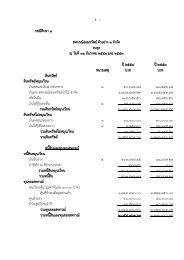The Projects under Her Royal Highness Princess Maha Chakri Sirindhorn (20)
The Projects under Her Royal Highness Princess Maha Chakri ...
The Projects under Her Royal Highness Princess Maha Chakri ...
- No tags were found...
You also want an ePaper? Increase the reach of your titles
YUMPU automatically turns print PDFs into web optimized ePapers that Google loves.
<strong>The</strong> <strong>Projects</strong> <strong>under</strong> <strong>Her</strong> <strong>Royal</strong> <strong>Highness</strong> <strong>Princess</strong> <strong>Maha</strong> <strong>Chakri</strong> <strong>Sirindhorn</strong> (<strong>20</strong>)<br />
Thai rice : linking the ancient to the globalization<br />
Rice is an important food crop as it is a<br />
major source of energy for about half of the world<br />
population. Thailand has been recognized as one of<br />
the world’s biggest rice exporters. It has served as an<br />
emergency source of supply for needed countries in<br />
several world food shortage times. Thai rice has a<br />
unique characteristic of a long slender and translucent<br />
grain with pleasant odor. At the world’s Grain Contest<br />
held in Regina, Canada, in 1933, Thai rice was first<br />
known to the world. ‘Pin Kaew’ won the first prize and other local varieties won the second, third and eight other<br />
prizes out of <strong>20</strong> prizes given. At present, Thai rice, especially Jasmine Rice (Khao Hom Mali), is well – known<br />
and popular worldwide because of its quality and aroma.<br />
To the Thai people, rice is the staple national food. At least 55 – 60% of daily calorie intake<br />
comes from rice. In some rural and remote areas, this number can be as high as 70%. Rice is eaten in many<br />
different ways. <strong>The</strong> milk – like liquid drained from boiling rice and high in vitamin contents is provided to the<br />
young, the elderly and the sick. Grounded rice mixed with salt and banana is given as weaning food. To increase<br />
its nutritive value, legume or sesame seeds can be added. Many Thai dessert dishes made from rice or rice<br />
flour mixed with other ingredients such as Krayasart, have high protein and are very nutritious snack bar.<br />
Rice has had an important role in Thais’ lives since the ancient time. It is not just staple food and<br />
economic crop of the nation, but it has been linked very closely with Thai traditions and culture. <strong>The</strong>re are traditional<br />
and ritual practices at every step of rice cultivation. Thais play respect to ‘Phra Mae Pho Sop’, the Mother of Rice or<br />
the Rice Goddess who protects and blesses rice fertility. <strong>The</strong> Rain – Begging Ceremony is a means of morale<br />
boosting for farmers by praying to Rain God for plenty of water. <strong>The</strong> Communal Voluntary Labor is a customary<br />
practice when family members, relatives, neighbors and everyone living in the same village gather to help each<br />
other plough, transplant, harvest and store the grains in granaries. This valuable custom creates fraternal love<br />
and cooperative spirits.<br />
To provide the morale support to farmers and wish them success in rice growing in each year,<br />
the <strong>Royal</strong> Ploughing Ceremony has been revived since 1960 by His Majesty King Bhumibol Adulyadej. <strong>The</strong> ceremony<br />
consists of two rites: the <strong>Royal</strong> Ploughing Rite which is to celebrate the spirits of rice seeds, legumes, maize,<br />
hays, sesame seed, etc. and the Annual First Ploughing Rite which is to mark the beginning of the rice growing<br />
season. His Majesty the King is concerned for the farmer’s way of living. <strong>The</strong> King experimented new varieties<br />
of rice and the planting of various kinds of crop to make most benefit out of the field at his residence, Chitralada
Palace. <strong>The</strong> rice seeds as well as seeds of rotation crops are packed in small bags to distribute to farmers all<br />
over the country. Those seeds are considered by the farmers to be auspicious and thus encourage them to do<br />
the farming.<br />
From<br />
Thai Rice by H.R.H. <strong>Princess</strong> <strong>Maha</strong> <strong>Chakri</strong> <strong>Sirindhorn</strong><br />
At International Rice Research Institute, Tokyo, Japan<br />
November 25, 1994.<br />
By following His Majesty the King’s footstep, <strong>Her</strong> <strong>Royal</strong> <strong>Highness</strong> has promoted Thai rice in<br />
many ways. In 1994, <strong>Her</strong> <strong>Royal</strong> <strong>Highness</strong> wrote a book entitled Thai Rice and gave a lecture at the 35 th Japan-<br />
International Rice Research Institute (IRRI) Day in Japan to disseminate the high value and the virtue of Thai<br />
rice. This book provides information on ‘Thai rice and Rice culture’ starting from the history of rice cultivation in<br />
Thailand to future prospect of Thai rice.<br />
<strong>Her</strong> <strong>Royal</strong> <strong>Highness</strong> has raised awareness and drawn attention about the value of Thai rice among<br />
the Thais particularly the young generation. <strong>The</strong> <strong>Princess</strong> herself participates in every step of rice cultivation<br />
from ploughing the soil with buffalo, driving the ploughing tractor to prepare the field, planting and harvesting<br />
the rice. In some schools in remote areas where there is enough land for rice cultivation, she has asked the<br />
schools to cultivate rice for their own consumption. Students engage in all steps of cultivation and many techniques<br />
have been taught. In some places, rice mills are also established to mill rice for consumption and sometimes to<br />
mill rice for the villages. <strong>The</strong> husks and brans are used for animal feeds.<br />
Research has been carried out to improve Thai rice production with long history of collaboration<br />
of foreign organizations especially Japan and IRRI since 1960. With growing modern technology, <strong>Her</strong> <strong>Royal</strong> <strong>Highness</strong><br />
has given guidance to the Thai researchers of the ‘Rice Genome Project’ of the National Center for Genetic<br />
Engineering and Biotechnology to conserve wild rice and native rice, including the main genes in those rice<br />
varieties. Thai rice varieties for higher yields and good nutritional quality can be improved for the benefit of Thai<br />
people as well as for the well – being of the world population.

















